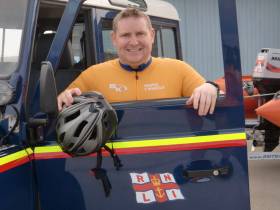Displaying items by tag: Waves2Wheels
Ten volunteer lifeboat crew from Ballyglass RNLI, in conjunction with Belmullet Cycling Club, will undertake a 150km cycle from Sligo Bay RNLI in Rosses Point to Ballyglass RNLI in Belmullet on Saturday 27 April.
A total of 130 cyclists from all over Ireland are registered to take part in the Waves-2-Wheels fundraiser which will see proceeds raised go to Ballyglass RNLI.
Allen Murray, Ballyglass RNLI station mechanic and Waves-2-Wheels chairperson, said he is overwhelmed by the hard work and dedication of all involved in getting the charity cycle from the rolling waves to the rolling road, and hopes it will be a safe and successful event.
“The idea was born last autumn when members of the lifeboat crew and the cycling club were discussing ways they could work together to raise funds in the locality,” Murray said.
“A charity cycle from a neighbouring lifeboat station to Ballyglass was suggested and agreed upon almost instantly. From there the hard work of organising the event and training began.
“A large number of the crew came on board to swap the sea for the saddle to raise much needed funds to maintain the high standard of training and equipment needed by Ballyglass RNLI volunteers to save lives at sea.”
Lifeboat coxswain and Waves-2-Wheels secretary James Mangan explained how important it is to raise awareness and funds for our lifeboats.
“Having two lifeboats working out of two locations both here at Ballyglass (all-weather lifeboat) and at Belmullet (inshore lifeboat) involves a lot of training and maintenance to ensure our volunteers and boats are ready 24/7 for whatever they may face when the pagers call them to sea.
“We are very lucky here in Mayo to have such wonderful supporters and sponsors and are very grateful to all who help us out in any way.
“When our volunteers launch to assist those in trouble at sea they know that they have the best of training and equipment to help bring them home safely. The crew kit alone costs between €1,000-€2,000, including lifejacket, and this gives the crew confidence to face various conditions and weathers, night or day.”
The RNLI’s two lifeboat stations in Mayo at Achill Island and Ballyglass launched 40 times in 2018 bringing 25 people to safety.
These rescues are only possible because of the donations made to the charity by supporters. And Waves-2-Wheels is currently accepting donations online ahead of the big ride in nine days’ time.
The cycle begins at Rosses point at 9am on Saturday 27 April, with the cyclists travelling through Easkey, Enniscrone, Ballina, Crossmolina and arriving at Belmullet’s inshore lifeboat station after 4pm.





























































